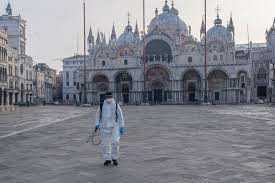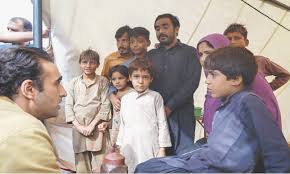Italy looks to life after lockdown

Milan: In Codogno, a small town in the northwestern region of Lodi, people have been confined to their houses for more than six weeks. But many aren’t anxious to see life go back to normal — at least, not yet.
Before the coronavirus epidemic hit, Codogno was a town just like any other in the region, with its low-lying, pastel-colored houses and surrounding fields.
That all changed in late February, when the community of 16,000 people suddenly appeared on every front page in Europe as ground zero of Italy’s rapidly exploding outbreak — and one of the first towns on the Continent to be fully locked down.
The transition from normal to coronavirus lockdown happened almost overnight. On February 21, a 38-year-old local man showed up at the hospital in a severe condition and tested positive for the virus. The next day, there were 40 new infections and two people had died. On February 23, Codogno and 10 nearby municipalities were shut down and formed part of a so-called red zone.
“The citizens were in shock,” Sara Boschiroli, a local psychologist who started a hotline to support residents, recalled.
As the contagion spread to other regions, Italy soon became a case study for researchers in the rest of Europe and the United States trying to predict how the virus would affect their communities.
Within Italy, authorities are studying Codogno’s trajectory for clues on how to adapt their response in other regions, which are some 15 days behind: How have lockdown measures affected the virus’s spread, and how are people reacting to the strict restrictions?
The first question is a little easier to answer than the second. The rapid lockdown seems to have had a positive effect: The number of new cases is close to zero and pressure on hospitals has eased — unlike in some municipalities in the province of Bergamo, which also saw serious outbreaks but in an attempt to protect the economy were not turned into red zones during the initial stages of the epidemic.
“Today, we are no longer in full emergency,” Stefano Paglia, the head of emergency services for Lodi and Codogno, said in an interview with the newspaper Il Giorno. “For the last three days, only about 30 people have come to the emergency room for symptoms attributable to COVID-19. Just three weeks ago there were between 100 and 120 a day.”
But while residents are relieved to be on the other side of the curve, many now fear what comes next.
“We have been in lockdown for 44 days, we are tired and above all we do not know when it will end,” said Monica Moretti, a mother of two who was laid off from her job in a lawyer’s office at the start of the crisis.
Her paycheck is not her greatest concern, she said.
“Sure we need money, but this is a conscious effort that I make to save others’ lives and my own. My biggest fear is that another outbreak will explode and that our sacrifice will have been in vain.”
Like Moretti, many in Codogno are worried that lifting restrictions will spark another outbreak.
The town’s official Facebook page is full of posts from people calling for even stricter measures. People frequently call out their neighbors on social media for going on a run or taking their children to the park, activities that are not allowed under the lockdown measures. Some even report these types of infringements to the police.
The prevailing feeling in the town is of restlessness and anxiety, said Boschiroli, the psychologist. And yet, fear that the curve has only flattened temporarily outweighs the desire for freedom.
“My patients are anxious and they feel that their lives are on hold,” said Boschiroli, but “they fear that the others will infect them.”
“You get used to being separated,” she added. “Now keeping your distance is normal. Unconsciously, you think the others can infect you, you don’t trust them anymore.”
Some fear it won’t be possible to return to “normal” life at all.
“In February, we thought that in a month it would all be over, but the more the days go by, the more I realize that it will be a long road,” said Stefano Oltolini, a Codogno resident who works for NGO Soleterre. “I feel we won’t get life back as we knew it.”
Oltolini used to travel with his family all over Europe on low-cost flights, he said. “I know it’s not vital, but the idea of not being able to do it makes me sad — not to travel means not to widen your mental boundaries.” The lockdown, he said, feels “infinite.”
Businesses, too, are anxious about how and when restrictions will ease up. Entrepreneurs, in many cases, are bearing the brunt of the emergency measures and fear for the future of their ventures.
“When they can, they try to make do by themselves, like some local supermarkets that have organized home deliveries,” said Laura Gozzini, a journalist who has been following COVID-19 up close for Il Cittadino, a local newspaper. “Many others cannot do anything, some have goods overstocked, and some have stopped production for a month and a half.”
For all of them, she added, “the €600 a month the government has allocated is ridiculous. But despite the difficulties, there is a great sense of responsibility.”
The national government left Codogno in the lurch, Francesco Passerini, the 35-year-old mayor of Codogno, said in an interview over the phone.
“We had requests, such as protective devices, but they did not listen to us,” said Passerini, a member of the far-right League party, which is in opposition to Italy’s ruling coalition. “We had to manage as much as we could, and now we produce disinfectant, distribute meals to the elderly and shop for those who cannot afford it.”
Still, he is proud, he said, of the way locals responded. “They demonstrated a respect for the rules that is moving.”
Passerini — who said he still wanders the deserted streets of his town with a megaphone reminding people to stay home — has fielded calls from officials hoping to draw lessons from his administration’s handling of the situation, including one last week from Tokyo.
Other parts of Italy are showing similarly encouraging signs that the peak of the epidemic is either nearing or already behind them. The number of intensive care and emergency room admissions is falling, and deaths are decreasing, even if the rate remains high.
But with the future still uncertain, even those who have been under lockdown the longest are reluctant to move forward too quickly.
Now that the shock has mostly passed, Codogno’s residents are taking stock of the toll the virus has taken on their community.
“Right now we are a wounded city that mourns its dead,” said Gozzini, the local reporter. “We have lost a generation of elderly people who made our history — like Giuseppe Vecchietti, the founder of the local civil protection agency, and Giovanni Ghessa, a commander of the carabinieri.”
Codogno recorded 124 deaths in the month after its first confirmed case. Don Igigno Passerini, the local parish priest, knew almost all of them.
Confinement measures meant he couldn’t be with them when they died, or hold funerals with those they left behind. The only option is still to pray alone or in small groups at the cemetery.
He recalled visiting a church in Codogno where 15 to 20 coffins were awaiting cremation. “I cried,” he said. “It was shocking, I’m used to seeing death, but not like that.”
As the weeks go by, he said has noticed that his community seems more peaceful and serene than at the start of the outbreak.
In his daily radio broadcasts and weekly live stream on Sundays, he relays the same message: “To all the faithful I say: Have trust, it will pass.” The only question is how — and when.





